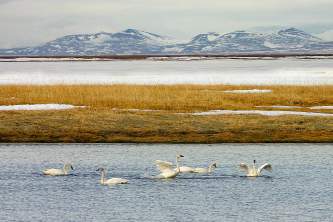Pilgrim River Bridge
The Pilgrim River crossing brings you close to groves of cottonwood that are abundant in this section of the valley. The presence of warmer soils associated with ground water springs contributes to the growth of deciduous trees.
Birding
A lower under story of tall, dense willow and alder attracts birds that are similar to those found at Pilgrim Hot Springs and often associated with boreal habitats. In the flood zone near the bridge, numerous beaver dams block the side sloughs and create ponds that are used by a variety of water birds. Arctic tern and gulls perch on the bridge railing to rest between feeding flights above the river. The tall vegetation adjacent to the north side of the bridge is a reliable place to find blackpoll warbler and northern water thrush.
Moose Viewing
Moose depend on the Pilgrim River for critical winter habitat. While moose typically disperse to willow-covered tributaries and side slopes in summer, cows and calves may remain along the main river in summer to feed on nutritious new shoots that spring from the ever-shifting gravel bars and shoreline.
Salmon Viewing
Sockeye salmon and a few Chinook salmon pass under the bridge on their way to Salmon Lake to spawn in July and August. Chum, coho, and pink salmon spawn between the bridge and Pilgrim Hot Springs. Whitefish sometimes school in the area close to freeze-up. Burbot and northern pike are found in these waters.



